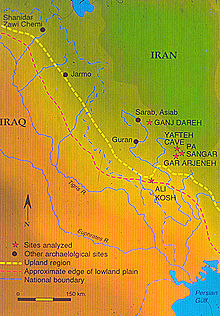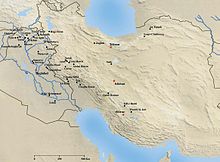Prehistory of Iran: Difference between revisions
No edit summary |
No edit summary |
||
| Line 1: | Line 1: | ||
The prehistory of Iran could be divided to Paleolithic, Epipaleolithic, Neolithic, and Chalcolithic periods as follow: |
The prehistory of Iran could be divided to Paleolithic, Epipaleolithic, Neolithic, and Chalcolithic periods as follow: |
||
[[File:Kermanshah Pal Museum-Neanderthal.jpg|thumb|A reconstruction of Iranian Neanderthal based on Shanidar fossils [[Zagros Paleolithic Museum]] ]] |
|||
== Paleolithic == |
== Paleolithic == |
||
One of the potential routes for early human migrations toward southern and eastern Asia is Iran, a country characterized by a wide range of geographic variation and resources, which could support early groups of hominins who wandered into the region. Evidence for the presence of these early populations in Iran includes sorne stone artifacts discovered From gravel deposits along the [[Kashafrud]] River Basin in eastern Iran,the Mashkid and Ladiz Rivers in the southeast, the [[Sefidrud]] River in the north, the [[Mahabad]] River in the northwest, and some surface occurrences and isolated finds From the west and northwestern parts of the country. |
One of the potential routes for early human migrations toward southern and eastern Asia is Iran, a country characterized by a wide range of geographic variation and resources, which could support early groups of hominins who wandered into the region. Evidence for the presence of these early populations in Iran includes sorne stone artifacts discovered From gravel deposits along the [[Kashafrud]] River Basin in eastern Iran,the Mashkid and Ladiz Rivers in the southeast, the [[Sefidrud]] River in the north, the [[Mahabad]] River in the northwest, and some surface occurrences and isolated finds From the west and northwestern parts of the country. |
||
| Line 23: | Line 23: | ||
[[File:Ganj dareh.jpg|thumb|right|Map showing location of Ganj Dareh and other early Neolithic sites in western Zagros.]] |
[[File:Ganj dareh.jpg|thumb|right|Map showing location of Ganj Dareh and other early Neolithic sites in western Zagros.]] |
||
[[File:Neolithic sites in Iran.jpg|thumb|left|Neolithic sites in Iran]] |
[[File:Neolithic sites in Iran.jpg|thumb|left|Neolithic sites in Iran]] |
||
[[Image:Sialk pot.jpg|thumb|left|Pottery vessel, fourth millennium B.C. Zagros [[National Museum of Iran]].]] |
|||
== References == |
== References == |
||
Revision as of 19:02, 28 May 2011
The prehistory of Iran could be divided to Paleolithic, Epipaleolithic, Neolithic, and Chalcolithic periods as follow:
Paleolithic
One of the potential routes for early human migrations toward southern and eastern Asia is Iran, a country characterized by a wide range of geographic variation and resources, which could support early groups of hominins who wandered into the region. Evidence for the presence of these early populations in Iran includes sorne stone artifacts discovered From gravel deposits along the Kashafrud River Basin in eastern Iran,the Mashkid and Ladiz Rivers in the southeast, the Sefidrud River in the north, the Mahabad River in the northwest, and some surface occurrences and isolated finds From the west and northwestern parts of the country.
The main known early human occupation sites in Iran are:Kashafrud in Khorasan,Mashkid and Ladiz in Sistan, Shiwatoo in Kurdistan, Ganj Par in Gilan, Darband Cave in Gilan, Khaleseh in Zanjan, Gakia in Kermanshah, Pal Barik in Ilam. These site fall between onee million years ago to 200,000 years ago.
Mousterian Stone tools made by Neanderthal man have also been found in various parts of the country.There are more cultural remains of Neanderthal man dating back to the Middle Paleolithic period, which mainly have been found in the Zagros region and fewer in central Iran at sites such as Shanidar]], Kobeh, Kunji, Bisetun, Qaleh Bozi, Tamtama, Warwasi.
Evidence for Upper Paleolithic and Epipaleolithic periods are known mainly from the Zagros region in the caves of Kermanshah and Khoramabad such as Yafteh Cave and a few number of sites in the Alborz range and Central Iran.
Epipaleolithic
The end of the Palaeolithic, called “Epipalaeolithic”,is in a period of about 7000 years from c. 18,000 to 11,000 BC. In those days groups of hunter-gatherers were mostly living in the caves of the Zagros Mountains. Compared to earlier groups of game hunters, a tendency towards increasing the number of the kinds of plants and animals, which were collected and hunted, can be observed. Not only smaller vertebrates were hunted but also pistachios and wild fruit were collected. Finally, consuming snails and smaller aquatic animals like crabs is new (Flannery 1973).
Neolithic
We know almost nothing about the 2500 years which followed the Epipalaeolithic after 11,000 BC. Only when discovering the place of Asiab (c. 8500-8000) in the Kermanshah area we are in better known periods. Asiab was a small camp of hunter-gatherers, only seasonally inhabited. Besides the fact that wild goats and sheep were hunted, great numbers of snail shells were found. These finds were interpreted in the way that from time to time the hunting activities of the inhabitants of Asiab were unsuccessful and that then they were forced to consume food which they usually did not like. Some nearby and more constantly occupied settlements in the Zagros date from a short time after Asiab, from the time between 8000 and 6800 BC. Still the material culture of Tappeh Ganj Dareh and Tappeh Abdul Hosein does not include any pottery. Thus this period is often called “aceramic Neolithic”. This is also true for the oldest levels of Tappeh Guran, located in Luristan, as well as for the sites of Ali Kosh and Chogha Sefid in the plain of Deh Luran, west of the Zagros Mountains. There, flocks of sheep and herds of goats were kept for the first time. Managing animals meant a fundamentally new orientation of the Neolithic inhabitants of Iran and must be understood to be connected with a whole number of other innovations, particularly the architecture of houses. We do not definitely know if in those days there was any cultivation of cereals. Tools for harvesting and for making cereal products are there, but remnants of burned grain are extremely rare.



References
- Bernbeck, R. (2004) Iran in the Neolithic, in T. Stöllner, R. Slotta and A. Vatandoust (eds) Persiens. Antike Pracht. Bochum: Bochum Museum, 140-147
- Biglari, F. and S. Shidrang, 2006 "The Lower Paleolithic Occupation of Iran", Near Eastern Archaeology 69 (3–4): 160-168
- Smith, P. E. L. (1986) - Paleolithic archaeology In Iran,Philadelphia (PA): University
Museum, University of Pennsylvania.
